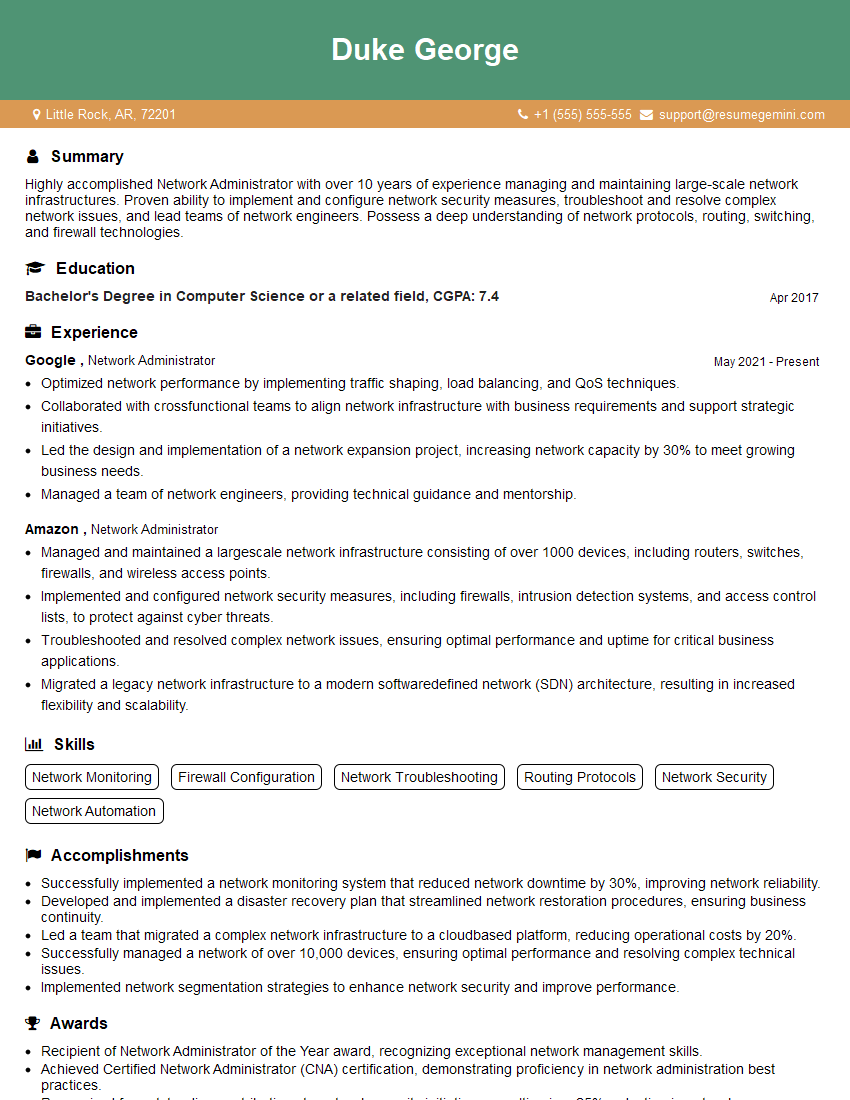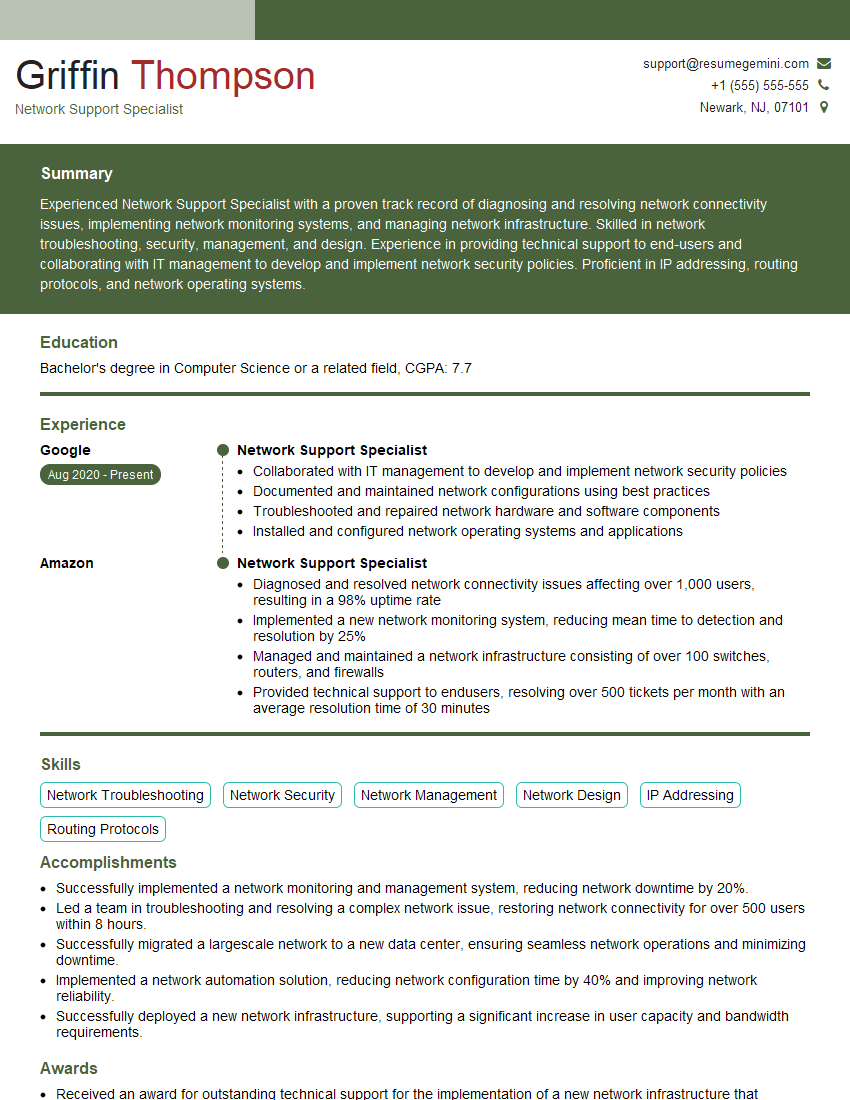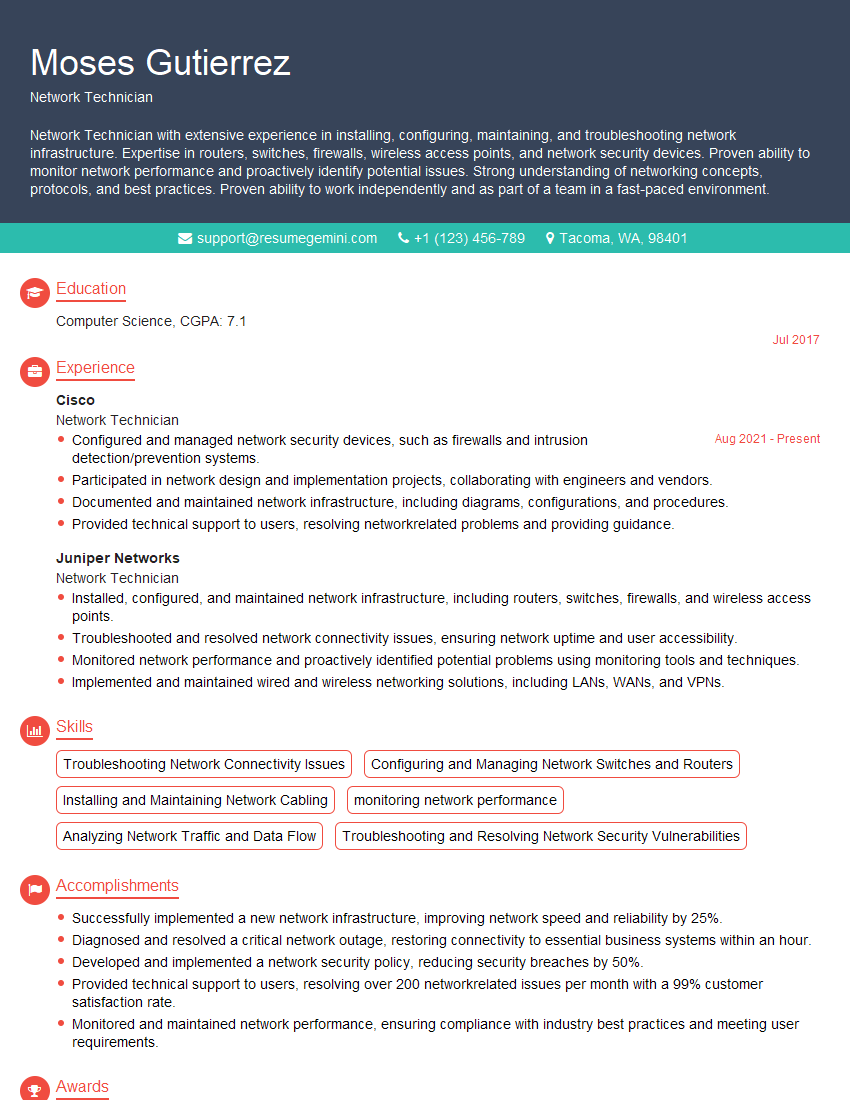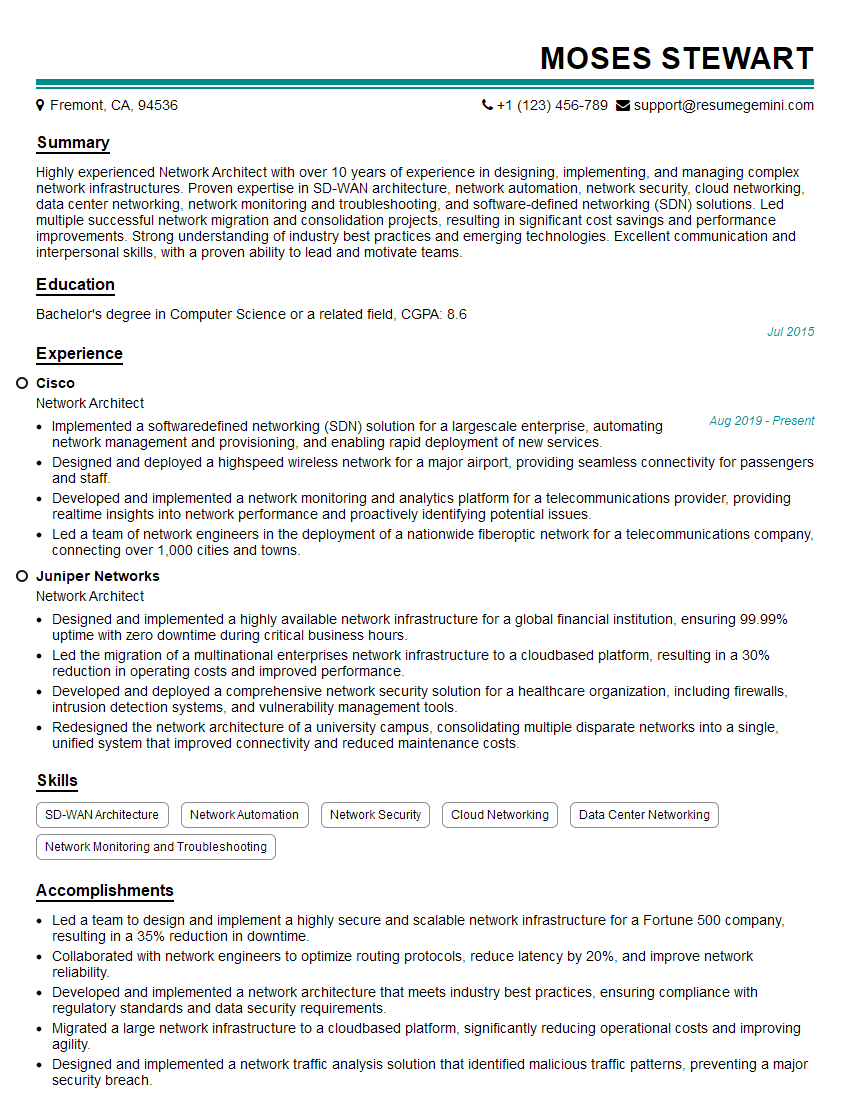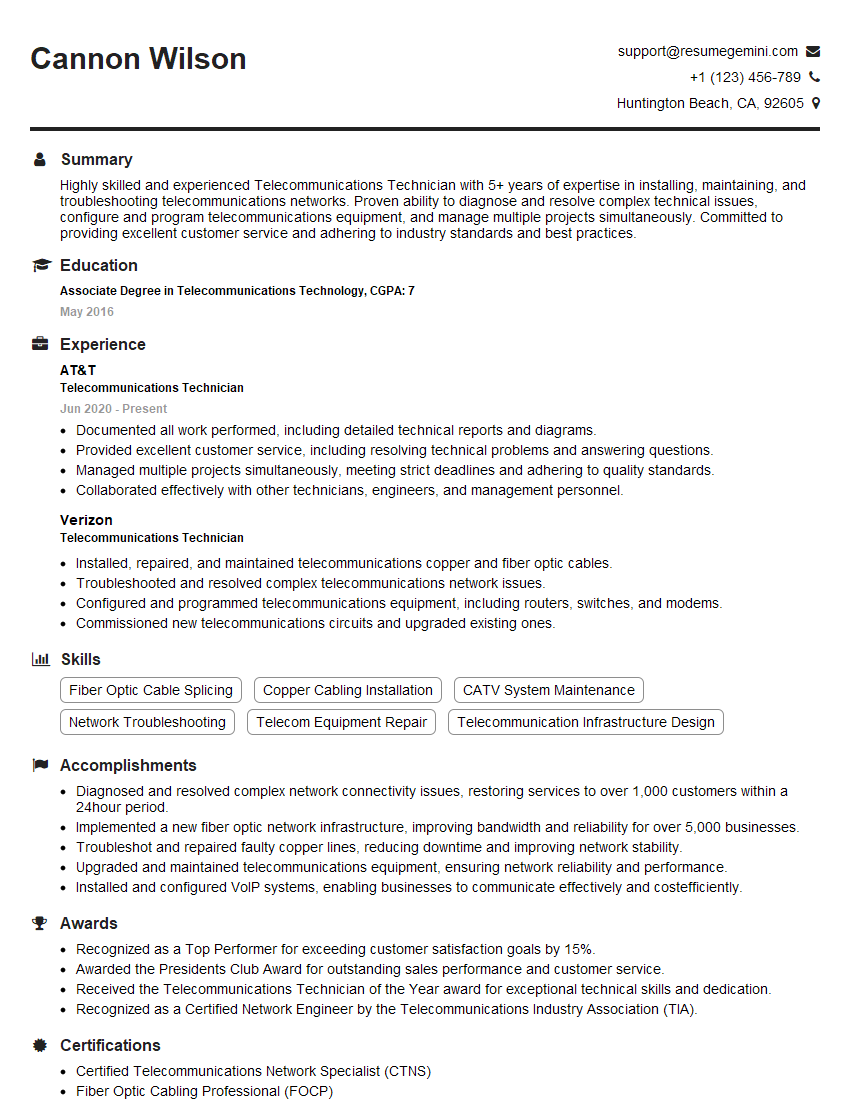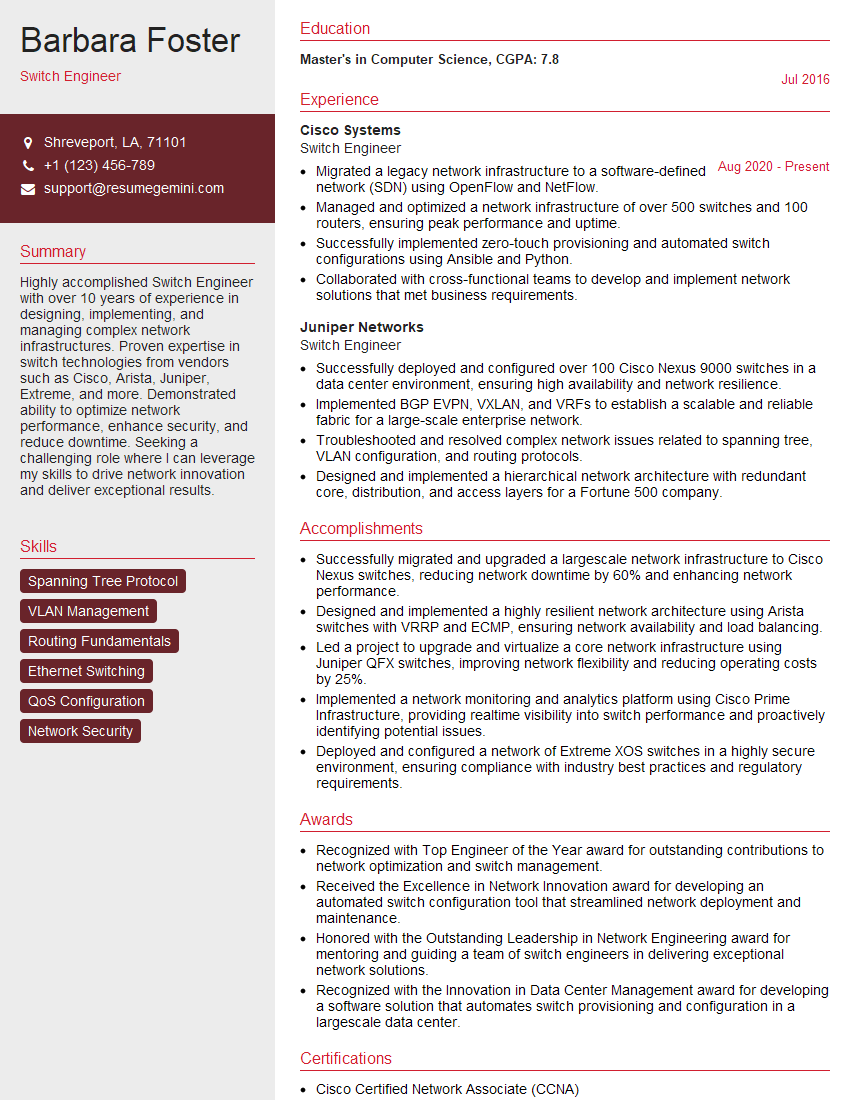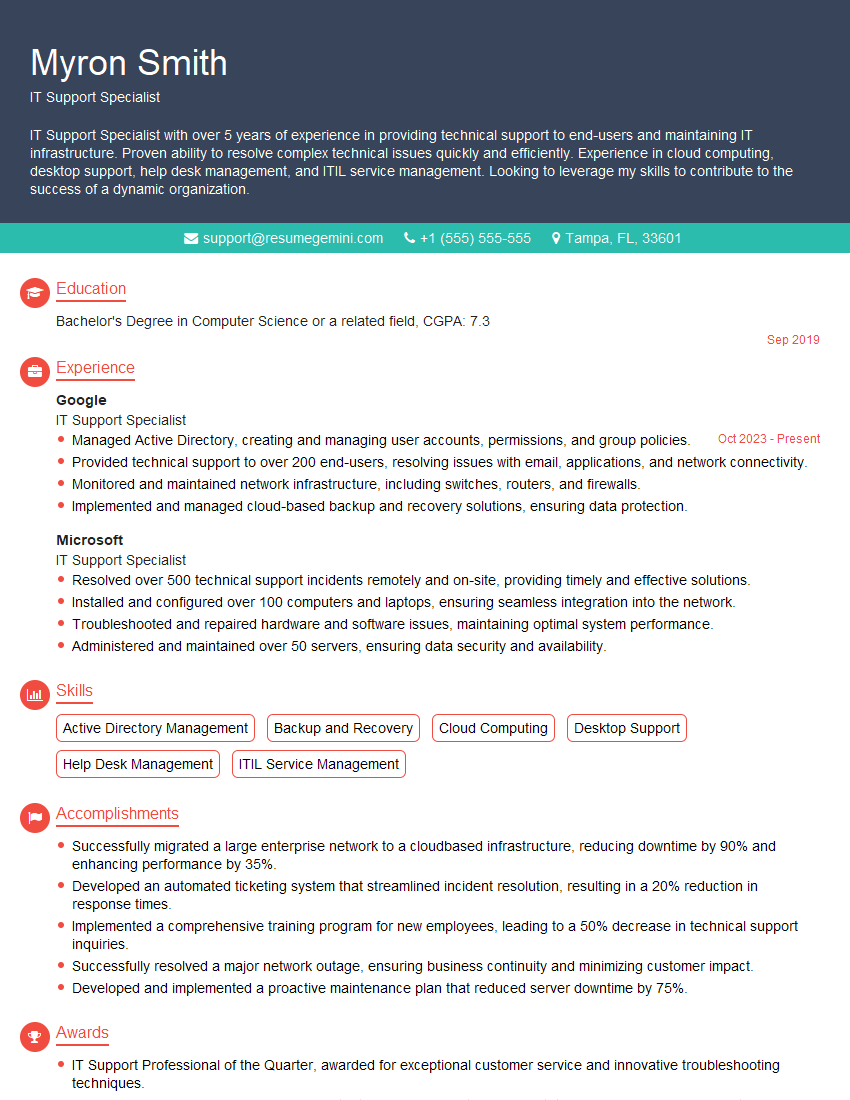The thought of an interview can be nerve-wracking, but the right preparation can make all the difference. Explore this comprehensive guide to Switch and Crossover Maintenance interview questions and gain the confidence you need to showcase your abilities and secure the role.
Questions Asked in Switch and Crossover Maintenance Interview
Q 1. Explain the difference between a straight-through and crossover cable.
The difference between a straight-through and a crossover cable lies in how they connect the transmit (Tx) and receive (Rx) pairs of wires. A straight-through cable connects Tx to Tx and Rx to Rx, suitable for connecting a computer to a switch or hub. Imagine it like a direct line of communication. A crossover cable, on the other hand, swaps Tx and Rx, connecting Tx to Rx and vice versa. This is necessary to connect two similar devices directly, like two switches or two computers, because they both try to transmit and receive on the same pairs. Think of it like a bridge, redirecting traffic between two similar ‘roads’.
Example: You’d use a straight-through cable to connect your laptop to your network’s switch. To directly connect two switches for a temporary backup link, a crossover cable would be required.
Q 2. How do you troubleshoot a network connectivity issue using a crossover cable?
Troubleshooting network connectivity with a crossover cable often involves verifying direct device-to-device communication, bypassing the switch or router. This helps isolate whether the problem lies with the network infrastructure or the specific devices.
- Identify the problem: Determine which two devices aren’t communicating (e.g., two switches, two PCs).
- Connect with crossover cable: Connect the two devices using a crossover cable (check if the devices are properly configured for the chosen speed and duplex).
- Test connectivity: Attempt communication between the devices (e.g., ping, file transfer). If successful, the issue lies within the network infrastructure (switch, router, cabling); if not, the issue is likely with the devices themselves.
- Analyze the results: If connectivity is good with the crossover cable, you’ll need to troubleshoot the main network switch or router. If it’s still failing, it points to problems with the network cards or configurations of your individual devices.
Example: If two switches aren’t communicating, use a crossover cable to directly link them. If they now communicate, the original issue is likely a misconfiguration of the main network switch or a failed link in the cabling between them.
Q 3. What are the common causes of switch port errors?
Switch port errors can stem from various sources. Identifying the cause requires careful observation and analysis of switch logs and network monitoring tools.
- Cable problems: Faulty or damaged cables are a major culprit. Poor termination, crimping errors, or physical damage can disrupt communication.
- Port configuration errors: Incorrectly configured port settings (duplex mismatch, speed mismatch, flow control issues) cause communication failures. For instance, a full-duplex setting on one device mismatched to half-duplex on another will result in dropped packets.
- Device malfunctions: Problems with the network interface card (NIC) in the connected device or a malfunctioning switch port itself can cause errors.
- Broadcast storms: Excessive broadcasts flooding the network can overwhelm the switch ports, resulting in errors.
- Physical layer issues: Problems with the physical media (fiber, copper) such as bad connectors or poor signal quality can lead to errors.
- Duplex Mismatch: Inconsistent Full-Duplex and Half-Duplex settings between connected devices cause transmission and receiving conflicts.
Example: Observing a high number of CRC (Cyclic Redundancy Check) errors on a specific port strongly indicates a cabling problem that should be addressed by replacing the cable and/or testing it for integrity using a cable tester.
Q 4. Describe the process of configuring a VLAN on a switch.
Configuring VLANs (Virtual LANs) on a switch involves segmenting the network into logically separate broadcast domains. This improves security, performance, and manageability.
- Create VLANs: Use the switch’s command-line interface (CLI) or web interface to create VLANs, assigning each a VLAN ID (e.g., VLAN 10, VLAN 20).
- Assign ports to VLANs: Assign switch ports to specific VLANs. This determines which VLAN traffic will pass through each port. A port can only belong to one VLAN at a time, although some switches support ‘trunking’, which allows a port to carry traffic from multiple VLANs.
- Configure inter-VLAN routing: If communication between VLANs is required, you’ll need a router or a VLAN routing feature on the switch to route traffic between the different VLANs.
- Verify configuration: Use commands like
show vlanor the equivalent web interface tools to check that VLANs are correctly configured and ports assigned properly.
Example: You could create VLAN 10 for marketing, VLAN 20 for accounting, and VLAN 30 for guest Wi-Fi. Ports connected to marketing workstations would be assigned to VLAN 10, and so on. A router would then be needed to enable communication between these VLANs.
Q 5. How do you identify and resolve a broadcast storm on a network?
A broadcast storm is a network condition where excessive broadcast traffic overwhelms the network, causing performance degradation and potential network outages. Think of it like a rumor spreading uncontrollably!
- Identify the storm: Monitor switch ports for unusually high traffic. Look for errors and unusual broadcast traffic using network monitoring tools. High CPU utilization on the switch is another tell-tale sign.
- Locate the source: Use tools like packet sniffers or switch port monitoring to identify the source of the excessive broadcast traffic.
- Isolate the source: Temporarily disable the source device or port to stop the storm. If there is no specific source, look for loops in your network.
- Correct the problem: This will vary depending on the cause: a faulty device might need replacing; a network loop might require fixing by disabling redundant connections (Spanning Tree Protocol will prevent this normally). Addressing the root cause is crucial.
- Implement preventative measures: Use network segmentation (VLANs), limit broadcast traffic, or implement stricter network security measures to prevent future storms.
Example: A misconfigured workstation sending out excessive broadcasts can cause a storm. Disabling that workstation’s port would temporarily resolve the issue, while troubleshooting the workstation’s configuration would solve the problem permanently.
Q 6. Explain the concept of spanning tree protocol (STP).
The Spanning Tree Protocol (STP) is a network protocol that prevents network loops. Network loops occur when there are redundant paths between network devices, creating a broadcast storm and causing network instability. STP acts like a traffic controller, ensuring that only one active path exists between any two network devices.
STP works by detecting loops and blocking redundant paths to prevent the broadcast storm. It uses a sophisticated algorithm to elect a root bridge, which is the central point of the network. All other bridges then learn their roles and block certain ports to eliminate loops.
Example: Imagine two switches connected to each other through two different paths. Without STP, broadcasts would endlessly loop between the switches. STP would detect this loop and block one of the paths, ensuring that only one active path remains.
Common STP implementations include Rapid Spanning Tree Protocol (RSTP) and Multiple Spanning Tree Protocol (MSTP), which offer faster convergence and enhanced features compared to the original STP.
Q 7. How do you configure port security on a switch?
Port security enhances network security by restricting access to switch ports. It prevents unauthorized devices from connecting to the network.
- Enable port security: Use the switch’s CLI or web interface to enable port security on the desired ports.
- Configure security features: Specify security features such as MAC address limiting (allowing only specific MAC addresses to access the port), sticky learning (auto-learning and remembering MAC addresses), and maximum number of MAC addresses allowed per port.
- Set security violations: Configure how the switch should react to security violations (e.g., shutdown the port, send an alert).
- Verify configuration: Verify that port security is correctly configured and working by testing with valid and invalid MAC addresses.
Example: You might configure port security on a port connected to a sensitive server, allowing only the server’s MAC address to connect. Any other device attempting to connect would be blocked.
Important Note: Properly configured port security significantly enhances network security, however, remember to plan your MAC address settings accurately to avoid accidentally blocking legitimate devices.
Q 8. What are the different types of switch fabrics?
Switch fabrics are the internal architecture of a network switch that determines how it forwards data between ports. Think of it as the ‘highway system’ inside the switch. Different fabrics offer varying levels of performance and scalability. Here are some common types:
- Memory-based switch fabric: This is a simple design where all data passes through the switch’s central memory. It’s suitable for smaller switches with limited bandwidth requirements but can become a bottleneck in larger networks. Imagine a single, congested road handling all the traffic.
- Bus-based switch fabric: Data is transferred across a shared bus. This is more efficient than a purely memory-based design but still susceptible to bottlenecks as all traffic shares the same pathway. Think of it as a single, multi-lane highway, still prone to congestion during peak hours.
- Crossbar switch fabric: This uses a matrix of crosspoints allowing simultaneous communication between multiple input and output ports. This is highly scalable and offers high bandwidth but can be expensive. It’s like having multiple, independent highways connecting different parts of the city.
- Shared-memory switch fabric: This design uses shared memory to buffer packets allowing efficient handling of high bandwidth traffic. It’s a more advanced form compared to traditional memory based fabrics.
- Input-queued switch fabric: Packets are queued at the input port improving throughput and reducing latency.
The choice of switch fabric depends on factors such as network size, bandwidth requirements, and budget. Larger networks with high bandwidth needs usually require more advanced fabrics like crossbar or shared-memory designs to avoid performance bottlenecks.
Q 9. Describe the process of upgrading the firmware on a network switch.
Upgrading switch firmware is crucial for maintaining security and adding new features. It’s like installing a software update on your computer to improve performance and fix bugs. The process generally follows these steps:
- Backup Configuration: Before starting, always back up the current switch configuration. This is critical in case the upgrade fails. You can typically do this using commands like
copy running-config startup-config(Cisco). - Download Firmware: Download the appropriate firmware image from the vendor’s website. Ensure compatibility with your specific switch model.
- Transfer Firmware: Transfer the firmware image to a location accessible to the switch, such as a TFTP server or USB drive.
- Upgrade Process: Use the switch’s command-line interface (CLI) to initiate the upgrade. The exact commands vary depending on the vendor and model. A common approach involves using a command like
copy tftp://(Cisco) ./ flash: - Reboot: The switch will usually reboot automatically after the firmware is loaded. This can take several minutes. Monitor the switch’s status during this time.
- Verification: After the reboot, verify the firmware version using the CLI (e.g.,
show versionon Cisco).
Always perform firmware upgrades during off-peak hours to minimize disruption. Read the vendor’s release notes carefully before upgrading to understand any potential issues or changes.
Q 10. How do you monitor switch performance and identify potential bottlenecks?
Monitoring switch performance helps identify bottlenecks and proactively address network issues before they impact users. Think of it as regularly checking your car’s engine to prevent major breakdowns. Several methods are used for monitoring:
- CLI Commands: Switch CLI provides valuable information. Commands like
show interface status(Cisco),show cpu, andshow memoryshow real-time information on interface utilization, CPU load, and memory usage. High CPU utilization or near-maximum interface utilization indicates potential bottlenecks. - SNMP: Simple Network Management Protocol (SNMP) allows network management systems (NMS) to collect data from network devices, including switches. This enables centralized monitoring and automated alerts.
- Network Monitoring Tools: Tools like SolarWinds, PRTG, or Nagios provide comprehensive network monitoring capabilities, including detailed switch performance metrics, visualizations, and alerts.
By analyzing data such as CPU utilization, memory usage, interface errors, and packet drops, you can identify potential bottlenecks. For instance, consistently high CPU utilization might indicate a need for a more powerful switch, while high error rates on a particular interface suggest a physical cabling or connectivity problem.
Q 11. What is the difference between Layer 2 and Layer 3 switches?
The key difference lies in the OSI model layer they operate on:
- Layer 2 (Data Link Layer) Switches: These switches operate at the data link layer and forward frames based on MAC addresses. Think of them as forwarding mail based on the recipient’s physical address. They are responsible for creating broadcast domains and learning MAC addresses to improve efficiency in LAN environment.
- Layer 3 (Network Layer) Switches (also known as Multilayer Switches or Routers): These switches also perform Layer 2 functions but also incorporate routing capabilities. They use IP addresses for routing decisions, similar to forwarding mail based on the recipient’s city or state which is more efficient in larger networks. They can route traffic between VLANs and different networks, effectively connecting multiple LANs.
In essence, Layer 3 switches combine the functionality of a Layer 2 switch and a router, offering more advanced routing and network segmentation capabilities.
Q 12. Explain the concept of trunking in a switched network.
Trunking allows multiple VLANs to share a single physical link between switches. Imagine it as a multi-lane highway carrying different types of traffic (VLANs) simultaneously. This increases bandwidth efficiency and simplifies network management. It’s commonly configured using the 802.1Q standard, which encapsulates VLAN tags into Ethernet frames. Here’s how it works:
- Negotiation: Switches on either end of the trunk negotiate to determine the allowed VLANs that can pass through. Common negotiation protocols include Dynamic Trunking Protocol (DTP) and Link Aggregation Control Protocol (LACP).
- Tagging: Each frame transmitted on the trunk includes a VLAN tag that indicates which VLAN the frame belongs to.
- Untagged VLAN (Native VLAN): A single, untagged VLAN is used for management and other out-of-band traffic.
Trunking is vital in larger networks where multiple VLANs need to communicate efficiently and there’s a need to conserve physical cabling.
Q 13. How do you troubleshoot a slow network connection?
Troubleshooting slow network connections requires a systematic approach. It’s like diagnosing a car problem – you need to check different parts before finding the root cause.
- Identify the Scope: Is the problem isolated to one machine, a specific application, or the entire network?
- Check Physical Connections: Ensure cables are properly connected and there are no physical faults.
- Ping Tests: Use the
pingcommand to test connectivity to different devices. Slow or no response indicates connectivity issues. - Traceroute: Use
traceroute(ortracerton Windows) to trace the path of packets to a destination. This helps identify bottlenecks or failing network devices along the path. - Check Switch Ports: Examine the switch ports using CLI commands. Look for errors, high utilization, or port status issues.
- Examine Network Monitoring Tools: Review performance metrics from network monitoring tools to identify bottlenecks and resource constraints.
- Check for Bandwidth Issues: Are there unusually high bandwidth consuming applications running that are impacting your network connection?
- Check for Software related problems: Are you running any antivirus or other security softwares that might be consuming high resources?
- Consider Wireless Interference (if applicable): Wireless interference can cause slow connections. Try changing channels or locations.
By systematically investigating these areas, you can narrow down the cause of the slow connection and implement appropriate solutions.
Q 14. What are the common commands used to configure a Cisco switch?
Cisco switches are widely used and their configuration relies heavily on the CLI. Here are some common commands:
enable: Enters privileged EXEC mode.configure terminal: Enters global configuration mode.interface: Enters interface configuration mode (e.g.,interface GigabitEthernet0/1).no shutdown: Enables an interface.ip address: Assigns an IP address to an interface.switchport mode access: Configures an interface as an access port (for Layer 2).switchport mode trunk: Configures an interface as a trunk port (for Layer 2).switchport trunk encapsulation dot1q: Configures 802.1Q trunking.switchport access vlan: Assigns an access port to a VLAN.vlan: Creates a VLAN.name: Assigns a name to a VLAN.show running-config: Displays the current configuration.show ip interface brief: Shows the status of all interfaces.show version: Displays switch hardware and software information.copy running-config startup-config: Saves the running configuration to the startup configuration.
These are just a few examples. The actual commands used will depend on the specific configuration task. Remember to consult Cisco’s documentation for detailed information and best practices.
Q 15. Explain the concept of Quality of Service (QoS).
Quality of Service (QoS) is a set of functionalities that ensures a certain level of performance to network traffic. Think of it like a traffic management system for your network. Instead of all traffic being treated equally, QoS allows you to prioritize certain types of data, ensuring that critical applications get the bandwidth they need, even during periods of high network congestion. For example, VoIP calls need low latency to avoid choppy audio; QoS ensures this by prioritizing VoIP packets over less time-sensitive traffic like file transfers.
Without QoS, a surge in less important traffic can negatively impact critical applications. Imagine a hospital network where medical imaging data competes with casual web browsing. QoS would ensure the medical images are prioritized, guaranteeing timely diagnosis and treatment.
Career Expert Tips:
- Ace those interviews! Prepare effectively by reviewing the Top 50 Most Common Interview Questions on ResumeGemini.
- Navigate your job search with confidence! Explore a wide range of Career Tips on ResumeGemini. Learn about common challenges and recommendations to overcome them.
- Craft the perfect resume! Master the Art of Resume Writing with ResumeGemini’s guide. Showcase your unique qualifications and achievements effectively.
- Don’t miss out on holiday savings! Build your dream resume with ResumeGemini’s ATS optimized templates.
Q 16. How do you implement QoS on a network switch?
Implementing QoS on a network switch typically involves configuring features like prioritization schemes (like Weighted Fair Queuing or Class-Based Queuing), bandwidth allocation, and traffic shaping. This is usually done through the switch’s command-line interface (CLI) or a graphical user interface (GUI).
For example, using Cisco IOS, you might assign different traffic classes based on protocols (VoIP gets higher priority) or ports (critical servers on specific ports are given preferential treatment) using commands like ip access-list and class-map. This allows the switch to intelligently manage and route network traffic to ensure critical applications maintain performance. We also utilize policies to limit the bandwidth a specific type of traffic can consume so one application doesn’t hog all the bandwidth.
Different vendors have their own proprietary mechanisms, but the underlying principles remain the same: identify critical traffic, assign higher priority, and manage bandwidth efficiently. Juniper uses similar concepts through their JunOS operating system, achieving similar results with their own command structures.
Q 17. What is MAC address learning and flooding?
MAC address learning is the process by which a switch builds a MAC address table. Each device on the network has a unique Media Access Control (MAC) address. When a device sends a frame, the switch learns its MAC address and the port it’s connected to. This information is stored in the MAC address table, allowing the switch to forward frames efficiently only to the intended recipient, avoiding unnecessary broadcasting.
MAC address flooding, on the other hand, happens when the switch doesn’t know the destination MAC address. In this case, the switch floods the frame out of all ports except the receiving port to find the destination device. This is less efficient than forwarding based on the MAC address table, as it creates unnecessary traffic.
Imagine a switch as a postal worker: MAC address learning is like building an address book; when a letter arrives, the worker knows exactly where to deliver it. MAC address flooding is like sending the letter to every house in the neighborhood until it finds the right one – far less efficient.
Q 18. What are the different types of network topologies?
Network topologies describe the physical or logical layout of a network. Common types include:
- Bus Topology: All devices connect to a single cable. Simple, but a single cable failure can bring down the entire network.
- Star Topology: All devices connect to a central hub or switch. This is the most common topology because of its scalability and ease of troubleshooting.
- Ring Topology: Devices are connected in a closed loop. Data travels in one direction. Less common nowadays.
- Mesh Topology: Multiple redundant paths between devices. Very robust, but complex and expensive.
- Tree Topology: A hierarchical structure, often used in larger networks combining elements of star and bus topologies.
The choice of topology depends on factors like network size, budget, and required reliability. Most modern networks use a star topology or a combination of topologies.
Q 19. Explain the concept of network segmentation.
Network segmentation is the practice of dividing a network into smaller, isolated segments. This improves security and performance. By separating different parts of the network, you limit the impact of a security breach or network failure. For instance, you might segment your network to separate sensitive data from public access points, or to isolate different departments within a company.
Segmentation is often achieved using VLANs (Virtual LANs), which allow you to logically group devices regardless of their physical location. Firewalls and routers can also be used to segment networks physically.
Think of it like dividing a large apartment building into smaller apartments. If a fire breaks out in one apartment, it’s less likely to spread to the whole building.
Q 20. How do you secure a network switch from unauthorized access?
Securing a network switch involves several layers of defense:
- Strong Passwords: Use strong, unique passwords for all administrative accounts and change them regularly. Implement password policies to enforce complexity.
- SSH Access: Disable Telnet and use SSH (Secure Shell) for remote management, encrypting all communications.
- Port Security: Configure port security to limit the number of MAC addresses allowed on each port, preventing unauthorized devices from connecting.
- Access Control Lists (ACLs): Use ACLs to filter traffic based on source/destination IP addresses, ports, or protocols. This restricts access to sensitive resources.
- Regular Firmware Updates: Keep the switch firmware up-to-date to patch security vulnerabilities.
- Regular Audits: Regularly audit switch configurations to ensure security settings remain effective.
- 802.1X Authentication: Implement 802.1X for strong authentication of devices connecting to the network.
A layered approach is essential for effective security. No single measure guarantees complete protection; a combination of these techniques significantly strengthens network security.
Q 21. Describe your experience with different switch vendors (e.g., Cisco, Juniper, HP).
I have extensive experience with Cisco, Juniper, and HP switches. My experience with Cisco encompasses various IOS versions, from configuring basic routing and switching to implementing advanced features like QoS, VLANs, and security policies on their Catalyst and Nexus lines. I’ve worked extensively with Juniper’s JunOS, focusing on their EX and QFX series, using their CLI for tasks such as network automation and implementing sophisticated security measures. With HP, my experience includes managing their ProCurve and Aruba switches, focusing on their feature-rich management interfaces and integrating them into larger network infrastructures.
Each vendor offers unique strengths. Cisco is known for its market dominance and extensive documentation. Juniper provides powerful automation capabilities, while HP often offers cost-effective solutions with excellent management tools. My expertise allows me to adapt to different vendor platforms and leverage their specific capabilities to meet project requirements.
Q 22. What is the difference between a managed and unmanaged switch?
The core difference between managed and unmanaged switches lies in their functionality and control. An Unmanaged Switch is a plug-and-play device; it simply forwards data packets based on their MAC addresses. Think of it like a simple intersection – cars (data packets) follow the designated paths (MAC addresses) without any central control. They are inexpensive and easy to set up, ideal for small networks with minimal configuration needs.
A Managed Switch, on the other hand, offers advanced features controlled via a network management interface, typically using a web browser or command-line interface. This allows for granular control over network traffic. Imagine a sophisticated traffic management system at a major intersection, capable of prioritizing certain vehicles (data streams), monitoring traffic flow, and even redirecting traffic in case of congestion. Features include VLAN (Virtual LAN) configuration, Quality of Service (QoS) prioritization, port security, and network monitoring capabilities, making them suitable for larger, more complex networks demanding advanced management and security.
In short: Unmanaged switches are simple and cost-effective for basic networking, while managed switches provide advanced control and features for complex and secure networks.
Q 23. How do you diagnose and resolve a loop in a switched network?
Network loops, where data packets endlessly circulate between switches, are a major cause of network congestion and outages. Diagnosing them involves a multi-step process. First, I’d use a network monitoring tool (like SolarWinds or PRTG, more on that later) to identify unusually high CPU utilization or packet loss on specific switches or ports. This often points to a loop.
Then, I would employ techniques like Spanning Tree Protocol (STP). STP is a protocol that prevents loops by selectively blocking redundant paths. If STP isn’t properly configured or working, that’s the likely culprit. I would verify its status on each switch, checking for errors or inconsistencies. STP’s implementation (like Rapid STP or MSTP) impacts the speed of loop detection and recovery.
If STP isn’t the issue, I would physically inspect the network cabling to see if there are any unintended connections. A mistakenly connected cable can easily create a loop. Lastly, packet analysis tools can pinpoint the looping packets, indicating the specific ports or devices involved, helping isolate the problem quickly. Resolving the loop usually involves disabling a redundant port, reconfiguring STP, or fixing the faulty cabling.
Q 24. Explain your experience with network monitoring tools.
My experience encompasses several leading network monitoring tools. I’ve extensively used SolarWinds Network Performance Monitor for comprehensive network monitoring, providing real-time visibility into network devices, bandwidth utilization, and application performance. Its alerting features are invaluable for proactive issue detection.
I’m also proficient with PRTG Network Monitor, known for its ease of use and ability to monitor various network technologies. Its customizable dashboards allow tailored monitoring based on specific network needs. In addition, I have experience with open-source solutions like Nagios and Zabbix, which offer flexibility but require more configuration and maintenance. My choice of tool depends on the scale and complexity of the network; for larger environments with demanding SLAs, SolarWinds’ robustness is preferred, while PRTG is suitable for smaller to medium-sized networks where simplicity is a key factor.
Q 25. What are the different types of network cables and their applications?
Network cables differ in their physical properties, transmission speeds, and applications. Here are some key types:
- Cat5e/Cat6/Cat6a: Twisted-pair copper cables used for Ethernet networks. Cat6a offers the highest bandwidth and is best for high-speed applications like 10 Gigabit Ethernet. Cat5e is suitable for Gigabit Ethernet but is becoming less common for new installations.
- Fiber Optic Cables: Utilize glass or plastic fibers to transmit data using light signals. They offer much higher bandwidth, longer distances, and better immunity to electromagnetic interference than copper cables. Used in backbone networks, long-haul connections, and high-speed data centers.
- Coaxial Cables: Used less frequently now, but still seen in older networks and for some specific applications. They offer better shielding than twisted-pair but have lower bandwidth.
The choice of cable depends heavily on the network requirements. For instance, a small office network might use Cat5e, while a data center would need fiber optic cables for its high-bandwidth demands.
Q 26. Describe your troubleshooting methodology for network issues.
My troubleshooting methodology follows a structured approach:
- Identify the Problem: Clearly define the issue. Is it a complete outage, slow performance, connectivity problems, or something else? Gather information from users, network monitoring tools, and available logs.
- Gather Information: Collect data from relevant sources. Check error logs on switches and routers, network monitoring tools, and user reports to pinpoint the cause. This may involve ping tests, traceroute, and other network diagnostic tools.
- Isolate the Problem: Narrow down the possible causes. Is the issue with a specific device, cable, or network segment? Divide and conquer the network using techniques like binary search.
- Develop a Solution: Based on the gathered information, formulate a solution. This could involve replacing a faulty cable, reconfiguring a device, or updating firmware.
- Implement and Test: Implement the solution carefully. Test thoroughly to confirm it has resolved the problem and hasn’t caused any new issues.
- Document the Solution: Thoroughly document the troubleshooting steps and the solution implemented for future reference and knowledge sharing.
This systematic approach ensures a thorough and efficient resolution of network issues.
Q 27. Explain your experience with network documentation and diagrams.
Network documentation is critical for efficient management and troubleshooting. My experience includes creating and maintaining detailed network diagrams (using tools like Visio or Lucidchart) illustrating the physical and logical layout of the network, including all devices, connections, and IP addressing schemes.
I also document network configurations, including device settings, VLAN configurations, routing tables, and security policies. This ensures that the network is easily understood and that changes can be made systematically and without unintended consequences. Clear documentation significantly reduces troubleshooting time and prevents errors during maintenance and upgrades. It’s also essential for handovers and knowledge transfer within a team. I maintain a version control system for all documentation, ensuring that updates are tracked and easily accessible.
Q 28. Describe a challenging network problem you solved and how you approached it.
One challenging problem involved intermittent network outages in a large corporate office. Initial diagnostics pointed to random packet loss, but the cause wasn’t immediately apparent. Network monitoring showed high CPU utilization on a specific switch during outage periods, but no obvious errors were logged.
After thorough investigation, including packet captures and analyzing network traffic patterns, I discovered that a specific application was sending extremely large multicast broadcasts during peak usage. This overloaded the switch’s processing capabilities, leading to dropped packets and the intermittent outages. The solution was a multi-pronged approach: optimizing the application to reduce multicast traffic, implementing QoS policies on the switch to prioritize critical traffic, and upgrading the switch to a model with higher processing power. The combination of these fixes solved the problem permanently.
Key Topics to Learn for Switch and Crossover Maintenance Interview
- Network Fundamentals: Understanding basic networking concepts like IP addressing, subnetting, routing protocols, and VLANs is crucial. This forms the foundation for troubleshooting and maintenance.
- Switch Architecture and Functionality: Learn about different switch types (Layer 2, Layer 3), switching methods (store-and-forward, cut-through), and the internal workings of switches. Be prepared to discuss port configurations and spanning-tree protocol (STP).
- Troubleshooting Common Switch Issues: Familiarize yourself with diagnosing and resolving common problems like connectivity issues, port errors, and broadcast storms. Practice applying your theoretical knowledge to real-world scenarios.
- Crossover Cable Concepts: Understand the purpose and function of crossover cables, including their use in connecting devices directly without a hub or switch. Know when and why they are necessary.
- Cable Management and Testing: Discuss best practices for organizing and maintaining network cables. Understanding cable testing tools and techniques is essential for efficient troubleshooting.
- Security Considerations: Be prepared to discuss basic network security concepts related to switches, such as port security, access control lists (ACLs), and security best practices for preventing unauthorized access.
- Practical Application: Think about how you would approach troubleshooting a network outage, identify faulty cables, or configure a new switch for a specific network segment. Prepare examples from your experience.
- Advanced Topics (for senior roles): Consider exploring topics like network automation, software-defined networking (SDN), and advanced routing protocols. This demonstrates initiative and advanced skills.
Next Steps
Mastering Switch and Crossover Maintenance is vital for career advancement in networking. It demonstrates a strong understanding of fundamental network principles and practical problem-solving skills, highly sought after by employers. To significantly boost your job prospects, crafting a professional and ATS-friendly resume is crucial. ResumeGemini is a trusted resource that can help you build a compelling resume that highlights your skills and experience effectively. Examples of resumes tailored to Switch and Crossover Maintenance roles are available to help guide you. Invest the time to create a strong resume; it’s your first impression and a key to unlocking your career potential.
Explore more articles
Users Rating of Our Blogs
Share Your Experience
We value your feedback! Please rate our content and share your thoughts (optional).
What Readers Say About Our Blog
good
